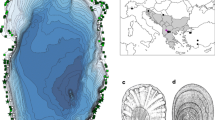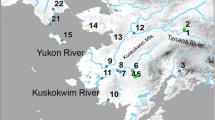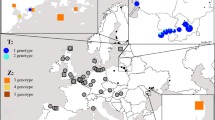Abstract
Ancient Lake Ohrid is characterized by vertical (bathymetrical) zones within the lake, presumably promoting allopatric speciation due to barriers or parapatric speciation along gradients. Examples within the lake include the belt of Chara algae as well as the shell zone, both presumably impeding migrations of benthic invertebrates. Three potential cases of vertical differentiation leading to distinct depth forms have been reported for the gastropod subfamily Pyrgulinae (Caenogastropoda: Hydrobiidae): Ginaia munda ssp., Macedopyrgula spp. and Ochridopyrgula macedonica ssp. Based on DNA data of the COI gene from a total of 145 specimens, this article aims at investigating the vertical differentiation within these depth forms and thus patterns of speciation in Lake Ohrid. An initial morphometric analysis showed a clear correlation of shell shape and collecting depth for Ginaia munda ssp. and Macedopyrgula spp. This morphological trend is largely reflected in the genetic structure of the respective taxa. The data presented here indicate the existence of strong gradients of abiotic and biotic factors in Lake Ohrid rather than distinct barriers. Therefore, parapatric speciation may be the predominant form of differentiation of benthic invertebrates in the lake. Incomplete lineage sorting, hybridization and phenotypic plasticity possibly caused by epigenetic mechanisms are discussed as possible reasons for the incongruence between geno- and phenotype observed in few specimens of Ginaia munda ssp. and Macedopyrgula spp. For the third taxon, Ochridopyrgula macedonica ssp., morphometric and genetic analyses revealed only weak support for the previously proposed depth forms. However, a horizontal differentiation of lake and spring populations was revealed instead, and parapatric and allopatric differentiations are discussed in this taxon.





Similar content being viewed by others
References
Albrecht, C. & T. Wilke, 2008. Ancient Lake Ohrid: biodiversity and evolution. Hydrobiologia 615: 103–140.
Albrecht, C., S. Trajanovski, K. Kuhn, B. Streit & T. Wilke, 2006. Rapid evolution of an ancient lake species flock: freshwater limpets (Gastropoda: Ancylidae) in the Balkan Lake Ohrid. Organisms Diversity and Evolution 6: 294–307.
Albrecht, C., C. Wolff, P. Glöer & T. Wilke, 2008. Concurrent evolution of ancient sister lakes and sister species: the freshwater gastropod genus Radix in lakes Ohrid and Prespa. Hydrobiologia 615: 157–167.
Albrecht, C., T. Hauffe, K. Schreiber, S. Trajanovski & T. Wilke, 2009. Mollusc biodiversity and endemism in the putative ancient Lake Trichonis (Greece). Malacologia 51: 357–375.
Avise, J. C., 2000. Phylogeography: the history and formation of species. Harvard University Press, Cambridge.
Berger, J. & M. Schagerl, 2003. Allelopathic activity of Chara aspera. Hydrobiologia 501: 109–115.
Bolnick, D. I. & B. M. Fitzpatrick, 2007. Sympatric speciation: models and empirical evidence. Annual Review of Ecology Evolution and Systematics 38: 459–487.
Bossdorf, O., C. L. Richards & M. Pigliucci, 2008. Epigenetics for ecologists. Ecology Letters 11: 106–115.
Brooks, J. L., 1950. Speciation in ancient lakes. Quarterly Review of Biology 25: 30–60.
Brusina, S., 1896. Bemerkungen über macedonische Süsswasser-Mollusken. Annalen des Naturhistorischen Hofmuseums Wien 3: 365–370.
Clement, M., D. Posada & K. A. Crandall, 2000. TCS: a computer program to estimate gene genealogies. Molecular Ecology 9: 1657–1659.
Coyne, J. A. & H. A. Orr, 2004. Speciation. Sinauer Associates, Inc., Sunderland.
Cristescu, M. E., S. J. Adamowicz, J. J. Vaillant & D. G. Haffner, 2010. Ancient lakes revisited: from the ecology to the genetics of speciation. Molecular Ecology 19: 4837–4851.
Doebeli, M. & U. Dieckmann, 2003. Speciation along environmental gradients. Nature 421: 259–264.
Excoffier, L. & H. E. L. Lischer, 2010. Arlequin suite ver 3.5: a new series of programs to perform population genetics analyses under Linux and Windows. Molecular Ecology Resources 10: 564–567.
Feinberg, A. P., 2007. Phenotypic plasticity and the epigenetics of human disease. Nature 447: 433–440.
Folmer, O., M. Black, W. Hoeh, R. Lutz & R. Vrijenhoek, 1994. DNA primers for amplification of mitochondrial cytochrome c oxidase subunit I from diverse metazoan invertebrates. Molecular Marine Biology and Biotechnology 3: 294–299.
Funk, D. J. & K. E. Omland, 2003. Species-level paraphyly and polyphyly: frequency, causes, and consequences, with insights from animal mitochondrial DNA. Annual Review of Ecology Evolution and Systematics 34: 397–423.
Gavrilets, S., H. Li & M. D. Vose, 2000. Patterns of parapatric speciation. Evolution 54: 1126–1134.
Gilbert, S. F. & D. Epel, 2009. Ecological Developmental Biology—Integrating Epigenetics, Medicine and Evolution. Sinauer Associates, Sunderland.
Glaubrecht, M., 2011. Towards solving Darwin’s “mystery”: speciation and radiation in lacustrine and riverine freshwater gastropods. American Malacological Bulletin 29: 187–216.
Glaubrecht, M. & T. von Rintelen, 2008. The species flocks of lacustrine gastropods: Tylomelania on Sulawesi as models in speciation and adaptive radiation. Hydrobiologia 615: 181–199.
Hadžišče, S., 1956. III. Beitrag zur Kenntnis der Gastropodenfauna des Ohridsees. - Beschreibungen der bis jetzt unbekannten Schnecken und Beispiele der Speciation bei den Gastropoden des Ohridsees. Recueil des Traveaux, Station Hydrobiologique Ohrid 4: 57–107.
Hall, T., 1999. BioEdit: a user-friendly biological sequence alignment editor and analysis program for Windows 95/98/NT. Nucleic Acids Symposium Series 41: 95–98.
Hammer, Ø., D. A. T. Harper & P. D. Ryan, 2001. PAST: paleontological statistics software package for education and data analysis. Palaeontologia Electronica 4: 1–9.
Hauffe, T., C. Albrecht, K. Schreiber, S. Trajanovski & T. Wilke, 2011. Spatially explicit analyses of gastropod compositions in ancient Lake Ohrid. Biogeosciences 8: 175–188.
Hollander, J., D. C. Adams & K. Johannesson, 2006. Evolution of adaption through allometric shifts in a marine snail. Evolution 60: 2490–2497.
Hubendick, B., 1960. The Ancylidae of Lake Ochrid and their bearing on intralacustrine speciation. Proceedings of the Zoological Society of London 133: 497–529.
Köhler, F. & G. Deein, 2010. Hybridisation as potential source of incongruence in the morphological and mitochondrial diversity of a Thai freshwater gastropod (Pachychilidae, Brotia H. Adams, 1866). Zoosystematics and Evolution 86: 301–314.
Magalhaes, I. S. & O. Seehausen, 2010. Genetics of male nuptial colour divergence between sympatric sister species of a Lake Victoria cichlid fish. Journal of Evolutionary Biology 23: 914–924.
Mantel, N., 1967. The detection of disease clustering and a generalized regression approach. Cancer Research 27: 209–220.
Martens, K., G. Coulter & B. Goddeeris, 1994. Speciation in ancient lakes—40 years after Brooks. In Martens, K., B. Goddeeris & G. Coulter (eds), Speciation in Ancient Lakes. Archiv für Hydrobiologie 44: 75–96.
Matzinger, A., Z. Spirkovski, S. Patceva & A. Wüest, 2006. Sensitivity of ancient Lake Ohrid to local anthropogenic impacts and global warming. Journal of Great Lakes Research 32: 158–179.
McGlue, M. M., M. J. Soreghan, E. Michel, J. A. Todd, A. S. Cohen, J. Mischler, C. S. O’Connell, O. S. Castaneda, R. J. Hartwell, K. E. Lezzar & H. H. Nkotagu, 2010. Environmental controls on shell-rich facies in tropical lacustrine rifts: a view from Lake Tanganyika’s littoral. Palaios 25: 426–438.
Michel, E., 2000. Phylogeny of a gastropod species flock: exploring speciation in Lake Tanganyika in a molecular framework. In Rossiter, A. & H. Kawanabe (eds), Biology of Ancient Lakes Biodiversity, Ecology and Evolution. Advances in Ecological Research 31: 275–302.
Oksanen, J., F. G. Blanchet, R. Kindt, P. Legendre, R. G. O’Hara, G. L. Simpson, P. Solymos, M. H. H. Stevens, & H. Wagner, 2011. vegan: Community Ecology Package, R package version 1.18-20. http://R-Forge.R-project.org/projects/vegan/. Accessed January 5, 2011.
Park, L. E. & K. F. Downing, 2000. Implications of phylogeny reconstruction for ostracod speciation modes in Lake Tanganyika. In Rossiter, A. & H. Kawanabe (eds), Biology of Ancient Lakes Biodiversity, Ecology and Evolution. Advances in Ecological Research 31: 303–330.
Peyer, S. M., J. C. Hermanson & C. E. Lee, 2010. Developmental plasticity of shell morphology of quagga mussels from shallow and deep-water habitats of the Great Lakes. Journal of Experimental Biology 213: 2602–2609.
Polinski, V., 1929. Limnolška ispitivanja Balkanskog Poluostrva I. Reliktna fauna gasteropoda Ohridskog Jezera. Glas Srpska Kraljevske Akademije Belgrade 137: 129–182.
Polinski, W., 1932. Die reliktäre Gastropodenfauna des Ohrida-Sees. Zoologische Jahrbücher Abteilung Systematik 62: 611–666.
R Development Core Team, 2009. R: A Language and Environment for Statistical Computing. R Foundation for Statistical Computing, Vienna, Austria, ISBN 3-900051-07-0. http://www.r-project.org.
Radoman, P., 1978. Beispiele der mikrogeographischen Speciation im Ohrid-See und die neue Gattung Adrioinsulana. Archiv für Molluskenkunde 109: 45–50.
Radoman, P., 1983. Hydrobioidea, a Superfamily of Prosobranchia (Gastropoda), I. Systematics. Serbian Academy of Sciences and Arts, Belgrade.
Radoman, P., 1985. Hydrobioidea, a Superfamily of Prosobranchia (Gastropoda), II. Origin, Zoogeography, Evolution in the Balkans and Asia Minor. Monographs Institute of Zoology 1, Beograd.
Rohlf, F. J., 2010a. tpsDig program, Version 2.12. Department of Ecology & Evolution, State University of New York.
Rohlf, F. J., 2010b. tpsUtil program, Version 1.46. Department of Ecology & Evolution, State University of New York.
Rossiter, N. & H. Kawanabe, 2000. Ancient lakes: biodiversity, ecology and evolution—advances in ecological research—preface. In Rossiter, A. & H. Kawanabe (eds), Biology of Ancient Lakes Biodiversity, Ecology and Evolution. Advances in Ecological Research 31: xii–xvi.
Russo, G. F. & F. P. Patti, 2005. Early life history of two closely related gastropods, Rissoa auriscalpium and Rissoa italiensis (Caenogastropoda: Rissoidae). Marine Biology 147: 429–437.
Seehausen, O., 2004. Hybridization and adaptive radiation. Trends in Ecology and Evolution 19: 198–207.
Stanković, S., 1960. The Balkan Lake Ohrid and Its Living World. Monographiae Biologicae, Vol. IX. Uitgeverij Dr. W. Junk, Den Haag.
Sturany, R., 1894. Zur Molluskenfauna der europäischen Türkei. Annalen des kaiserlich-königlichen naturhistorischen Hofmuseums 9: 369–390.
Sywula, T., Z. Krstanovski, O. Tasevska, J. Sell & T. Kretowicz, 2003. Genetic differences among several species of Tricladida from the relict Lake Ohrid as revealed by enzyme electrophoresis. Folia Biologica 51: 105–109.
Takhteev, V. V., 2000. Trends in the evolution of Baikal amphipods and evolutionary parallels with some marine Malacostracan fauna. In Rossiter, A. & H. Kawanabe (eds), Biology of Ancient Lakes Biodiversity, Ecology and Evolution. Advances in Ecological Research 31: 197–220.
Tamura, K., J. Dudley, M. Nei & S. Kumar, 2007. MEGA4: molecular evolutionary genetics analysis (MEGA) software version 4.0. Molecular Biology and Evolution 24: 1596–1599.
Thompson, J. D., D. G. Higgins & T. J. Gibson, 1994. CLUSTAL W: improving the sensitivity of progressive multiple sequence alignment through sequence weighting, positions-specific gap penalties and weight matrix choice. Nucleic Acids Research 22: 4673–4680.
Trajanovska, S., 2002. Distribution and surface of the belt of Charophyta in Lake Ohrid. Sbornik na Rabotite (Review) 35: 99–108.
Trajanovski, S., C. Albrecht, K. Schreiber, R. Schultheiß, T. Stadler, M. Benke & T. Wilke, 2010. Testing the spatial and temporal framework of speciation in an ancient lake species flock: the leech genus Dina (Hirudinea: Erpobdellidae) in Lake Ohrid. Biogeosciences 7: 3387–3402.
Trussell, G. C. & L. D. Smith, 2000. Induced defenses in response to an invading crab predator: an explanation of historical and geographic phenotypic change. Proceedings of the National Academy of the USA 97: 2123–2127.
Urdy, S., N. Gaudemand, H. Bucher & R. Chirat, 2010. Growth-dependent phenotypic variation of molluscan shells: implication for allometric data interpretation. Journal of Experimental Zoology Part B: Molecular and Developmental Evolution 314B: 303–326.
Van Bocxlaer, B. & R. Schultheiß, 2010. Comparison of morphometric techniques for shapes with few homologous landmarks based on machine-learning approaches to biological discrimination. Paleobiology 36: 497–515.
Van Speybroeck, L., 2002. From epigenesis to epigenetics: the case of C. H. Waddington. Annales of the New York Academy of Sciences 981: 61–81.
von Rintelen, T., K. von Rintelen & M. Glaubrecht, 2010. The species flocks of the viviparous freshwater gastropod Tylomelania (Mollusca: Cerithioidea: Pachychilidae) in the ancient lakes of Sulawesi, Indonesia: the role of geography, trophic morphology and color as driving forces in adaptive radiation. In Glaubrecht, M. & H. Schneider (eds), Evolution in Action. Springer, Berlin: 485–512.
Watzin, M. C., V. Puka & T. B. Naumoski (eds), 2002. Lake Ohrid and Its Watershed, State of the Environment Report. Lake Ohrid Conservation Project. Tirana, Albania and Ohrid, Macedonia.
West-Eberhard, M. J., 2005. Phenotypic accommodation: adaptive innovation due to developmental plasticity. Journal of Experimental Zoology Part B-Molecular and Developmental Evolution 304B: 610–618.
Wilke, T., G. M. Davis, D. C. Qiu & R. C. Spear, 2006. Extreme mitochondrial sequence diversity in the intermediate schistosomiasis host Oncomelania hupensis robertsoni: another case of ancestral polymorphism? Malacologia 48: 143–157.
Wilke, T., C. Albrecht, V. V. Anistratenko, S. K. Sahin & M. Z. Yildirim, 2007. Testing biogeographical hypotheses in space and time: faunal relationships of the putative ancient Lake Egirdir in Asia Minor. Journal of Biogeography 34: 1807–1821.
Wysocka, A., G. Kostoski, A. Kilikowska, B. Wrobel & J. Sell, 2008. The Proasellus (Crustacea, Isopoda) species group, endemic to the Balkan Lake Ohrid: a case of ecological diversification? Fundamental and Applied Limnology 172: 301–313.
Acknowledgments
We are very grateful to the colleagues of the Hydrobiological Institute Ohrid for their valuable support. D. Georgiev is acknowledged for providing us with his vast local expertise. All student colleagues are acknowledged for their help and commitment in the field work. We also thank S. Nachtigall and C. Wolff for their help with the DNA work. We thank R. Schultheiß for intense discussions on issues of incongruence between genetics, morphology and distribution. The constructive reviews from E. Michel and an anonymous referee are gratefully acknowledged. This work was supported by the Deutsche Forschungsgemeinschaft (DFG) grants WI 1902/8-1 and AL 1076/3-1.
Author information
Authors and Affiliations
Corresponding author
Additional information
Guest editors: C. Sturmbauer, C. Albrecht, S. Trajanovski & T. Wilke / Evolution and Biodiversity in Ancient Lakes
Electronic supplementary material
Below is the link to the electronic supplementary material.
Rights and permissions
About this article
Cite this article
Schreiber, K., Hauffe, T., Albrecht, C. et al. The role of barriers and gradients in differentiation processes of pyrgulinid microgastropods of Lake Ohrid. Hydrobiologia 682, 61–73 (2012). https://doi.org/10.1007/s10750-011-0864-4
Received:
Accepted:
Published:
Issue Date:
DOI: https://doi.org/10.1007/s10750-011-0864-4




